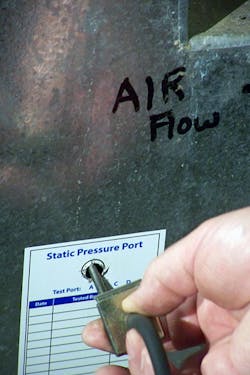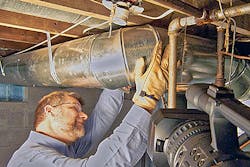The HVAC industry suffers from a worldwide pandemic. A pandemic is a global disease outbreak infecting hundreds of thousands or millions of people. Sick duct systems everywhere deteriorate the health and efficiency of installed HVAC systems. Unfortunately, this plague is off the radar of the World Health Organization. We are the world’s only hope to eradicate duct diseases.
Let’s take a look at the most devastating duct diseases, how to detect their symptoms, prescribe a cure, and perform the required surgery to return them to full health, one system at a time.
Coronary Artery Disease
In humans, this condition occurs as arteries become restricted, deteriorating circulatory system performance and the injuring the heart. In HVAC systems, inadequate duct sizing, crummy installation practices, and aging ductwork, damage an HVAC system’s distribution and fan performance, causing our first undersized duct disease - Ductus
Dwarfishness.
Coronary duct disease symptoms include, low airflow delivery from undersized ducts, and high duct static pressure. As with the human arteries, related symptoms can cause feelings of discomfort.
Measurement is necessary to confirm the actual problem exists and to quantify how great a toll the disease has taken on the system. In humans, that measurement is a blood pressure test. In ductwork, it is called the static pressure test. If static pressure is high, you need to find an immediate solution.
Airflow measurement is parallel to an electrocardiogram, which measures your heart’s blood flow. Airflow measurement determines your fan airflow and the amount of airflow delivered to each register or grille.
Improving a duct system is much easier than replumbing a human circulatory system. The risk is much lower to your customer. A typical duct system upgrade costs only $2,500 to $4,000. Add a couple zeroes for heart bypass surgery. If you use medical terms like coronary duct disease or Ductus Dwarfishness, perhaps you can increase your price by 150 percent, like the medical profession does.
The parallel between a heart bypass and duct system renovation is similar. Both procedures increase the distribution capacity and increase blood or air flow. Both are essential fluids to the system.
When the patient or your customer understands the problem and the solution, both are usually motivated to secure the needed repair, and have it corrected immediately.
Diagnostics may include testing the airflow leading to uncomfortable rooms and static pressure measurement. Compare live measurements to required airflows and pressures.
The typical solution for undersized ducts is to complete a duct system renovation. This procedure requires interpretation of the symptoms and prescribing a group of specific repairs that usually includes replacing underperforming ducts with larger ones. Each additional installation defect you identify is corrected. Some solutions may be as easy as opening a closed balancing damper.
Once you complete the duct renovation, or bypass surgery, you must then verify that you met the desired outcome.
In the hospital, a patient’s vital signs are monitored, recorded, and compared to previous measurements and health standards. When released from the hospital, patients are prescribed ongoing checkups to assure the desired outcome is maintained.
A duct system also requires testing, verification, and monitoring. This means testing system airflow and pressures at job completion to assure you achieved the intended outcome. Duct system pressure measurements at each maintenance visit provide ongoing system monitoring. If the pressures remain constant, your customer has assurance of a healthy duct system.
Stint Placement in Arteries
Angioplasty is the insertion of a stent to open clogged arteries leading to and from the heart. This is a much milder procedure than a heart bypass, and often produces the intended outcome with much less effort. By the way, it costs about one-tenth of a heart bypass.
Many duct systems contain restrictions that require repairs for the system to deliver the desired comfort and efficiency. Duct system restrictions are identified with grille airflow measurements.
To identify a blocked duct, measure room airflow and compare it to the estimated airflow amount the room requires. This detects a blocked duct. You can also inspect the duct to find obvious Ductus Obstructus (does that sound medical enough?) Or, squished ducts in plain English. Obstructed duct fittings or transitions can also restrict airflow and deteriorate installed system performance.
If you suspect an internal duct obstruction, you can measure the duct pressure every four feet or so down the length of the duct. A significant pressure change between two pressure measurements pinpoints the location of a duct restriction.
Common duct obstructions include loose interior insulation, external damage, debris left inside the ductwork, or pinched flexible ducts. Other causes include excessive elbows transitioning to the grille location and the occasional dead animal that once fatally sought a warm place to sleep.
Once this symptom is identified, the typical prescription is to repair or replace the restricted duct section. You may also install a rigid sheet metal fitting to improve airflow where a duct is damaged.
Leaky Blood Vessels
In the human world, doctors provide immediate attention to leaking blood vessels. Leaks in the eyes can cause blindness, leaks can cause organ failure, and leaking blood vessels are now linked to Alzheimer’s disease. The fact is, duct leakage is a reality in nearly every duct system. Your job is to assess how duct leakage impacts the rest of the system and make appropriate repairs.
Shoddy duct installation is quickly identified by visually inspecting the duct tightness level. If you find a lack of sealant or approved duct sealing material, that tells you a lot.
You can estimate live operating (actual) duct system leakage by measuring fan airflow and adding together total supply register airflow. Then subtract the two airflow values. The same is true for the return side of the system.
You solve duct leakage disease by sealing duct leaks. Refer to your local distributors for acceptable duct sealants in your city or state. The most important leaks to seal are near the equipment where system pressures are the highest. Please note that perfectly sealing every inch of your ducts doesn’t pay for you or your customers.
Ducts have diseases and you are the only one in the position to be their physician. You will find opportunity by testing, diagnosing, and curing this duct system pandemic that has swept the world for decades.
Rob “Doc” Falke serves the industry as president of National Comfort Institute, Inc., an HVAC-based training company and membership organization. If you're an HVAC contractor or technician interested in a free test procedure to discover duct diseases, contact Doc at [email protected] or call him at 800-633-7058. Go to NCI’s website at nationalcomfortinstitute.com for free information, articles, and downloads.
About the Author
Rob 'Doc' Falke
President
Rob “Doc” Falke serves the industry as president of National Comfort Institute an HVAC-based training company and membership organization. If you're an HVAC contractor or technician interested in a building pressure measurement procedure, contact Doc at [email protected] or call him at 800-633-7058. Go to NCI’s website at NationalComfortInstitute.com for free information, articles and downloads.




